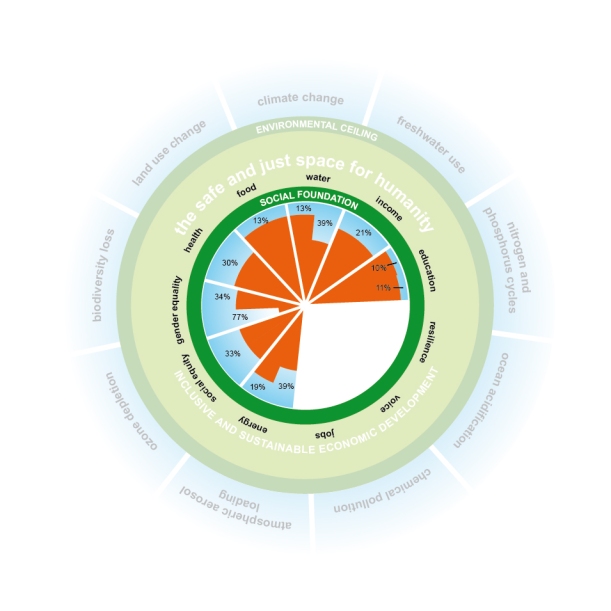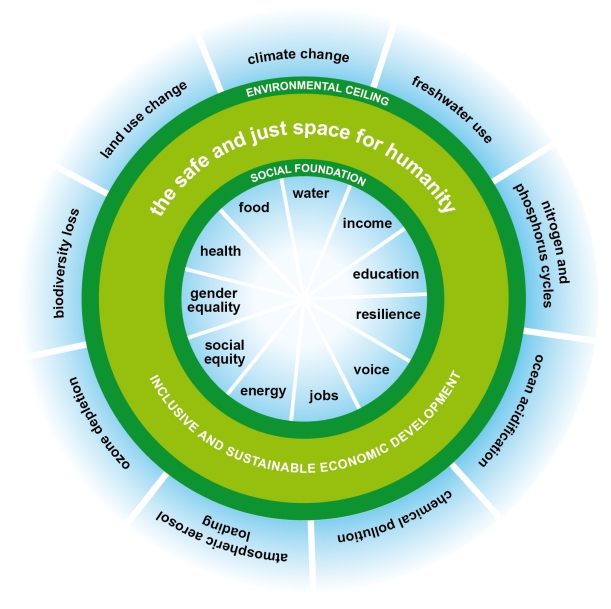Man, sometimes you just have to catch yourself in moments of pure luck. Like today, after a morning spent in glorious summer weather hammering out the last formatting issues of my thesis, when I was able to attend a lunch seminar (who said there was no free lunch in economics?) with the inspiring Kate Raworth and have a 2-hour chat afterward with her as well as some senior researchers in ecology, animal genetics, food systems and the like from SLU. What did we talk about? Basically, how to change the world. And economics education. But most of all, Raworth’s suggestion for a new framing of the global challenges and goals as we move from the Millennium Development Goals to the Sustainable Development Goals as of next year: the so-called “doughnut” of the safe and just operating space for humanity.
As Raworth explained, she was inspired by and built on the concept of Planetary Boundaries developed by Rockström et al., which we already talked about in a previous blogpost (more than a year ago! How time flies!). Basically, this is a theory by earth scientists on how human action affects different realms of our ecosystem – the outer 9 wedges of the circle – which all have ‘tipping points’ over which we should not venture because they could lead to unforeseeable damage to our entire habitable planet.
Well, great, Raworth thought – but clearly we can’t live in the very inside of the circle either where we don’t have any human impact on the planet? Because that would mean deprivation, human suffering, and a clear disregard for human rights – and from an anthropocentric perspective, we are trying to keep within the boundaries to enable human life to continue in a way worth living for generations to come. So what we need to aim for is to live within the band – or, if you will, the doughnut – that enables us to fulfill the needs of all without overloading the planet with impacts it cannot absorb.
But enough with fluffy concepts – we need to operationalize them too. We already know how the outer limits were defined – by Rockström and his team of scientists -, but how did Raworth come up with the inner minimum standards? She read through all government submissions for the Rio+20 conference on their development foci in the coming decades and found a common denominator in those categories that at least 50% of all governments mentioned. They are the wedges on the inside of the circle – health, resilience, and food for instance.
 When, in turn, you try to quantify these goals – using indicators assembled by the UN, such as the amount of food insecure households for the food category or the wage gap for gender equality – you realize that on a global scale, we are still falling short on all these goals. On the other hand, if you consider that we would only need 3% of the current agricultural production would be needed to end global hunger (around 1/10 of the estimated food wasted between farm and fork!), that only 1% of current greenhouse gas emissions would be spent to achieve global electrification, and that 50% of the world’s carbon emissions are produced by the 11% richest people – then you understand that the two goals of sustainability and development are not necessarily mutually exclusive (which is the purported reason why the climate negotiations keep stalling).
When, in turn, you try to quantify these goals – using indicators assembled by the UN, such as the amount of food insecure households for the food category or the wage gap for gender equality – you realize that on a global scale, we are still falling short on all these goals. On the other hand, if you consider that we would only need 3% of the current agricultural production would be needed to end global hunger (around 1/10 of the estimated food wasted between farm and fork!), that only 1% of current greenhouse gas emissions would be spent to achieve global electrification, and that 50% of the world’s carbon emissions are produced by the 11% richest people – then you understand that the two goals of sustainability and development are not necessarily mutually exclusive (which is the purported reason why the climate negotiations keep stalling).
Rather, what is needed according to Raworth is for the least developed countries to keep developing, but to avoid resource lock-ins; for the emerging countries, to pursue the relative de-coupling of GDP growth and resource throughput; and for the richest countries to pursue absolute de-coupling – to reduce our per-capita footprint on an absolute scale.
This is, however, where things get a little more complicated (and the summary ends and my personal opinion starts, just to make it clear). For here is where the hard questions of how to actually live within the doughnut start to emerge, questions to which the framework does not really provide answers. For some, the answer is voluntary simplicity and de-growth. For others, a swift turn towards a dematerialized sharing economy characterized by product-service-systems and virtual goods. And for some, the doughnut is actually just an alternative depiction of the ‘green growth’ idea. Here lies my beef (figuratively ;)) with these types of very inclusive, teleological (goal-driven) frameworks – we could talk for hours about how we agree that development needs to be balanced with greater sustainability, and I think the doughnut idea is a great visualization tool for that purpose (more on that in a second). But I don’t necessarily see it being different from the climate negotiations in the past where (Western) governments have argued for the need for global emission reductions while (developing) governments have argued for their right to develop – and where every side respectfully acknowledges the other’s points without engaging on the inherent contradiction between them out of diplomatic politeness. I fear that showing officials this diagram would achieve the same purpose – Raworth told an anecdote about Latin American leaders and European ones both finding their own policy goals reflected in the diagram and gossiping about the other side’s suspected disapproval of the framework – from a positive viewpoint, this could mean that we actually stand much closer on the issue than we realize. From a rather pessimistic perspective, maybe it just means that we see whatever we want to see in these types of frameworks without acknowledging the underlying complexities any further.
But – BUT – having countries agree to binding goals is at least currently one of the best ways to move forward, and I do think that calling this type of framing into the minds of policy-makers again and again will have a lasting impact when short-term high growth rates beckon (let’s hope so). And in view of current policy decisions, be it the Australian budget cuts that led to the International Symposium on Sustainable Development Goals 2015 to be called off, or the current TTIP negotiations that might sacrifice long-term public health and safety considerations for short-term trade goals, reminding policy-makers of this basic fact [“your decisions all occur in the framework of one functioning ecosystem”] might be more necessary than ever.
Furthermore, Raworth talked about ‘visual intelligence’, which I found fascinating – the fact that making these types of facts and connections visual leads us to understand and internalize them better. You guys know I love infographics and data visualization, but this presentation just made me even more aware about how important the (visual) framing of concepts and ideas really is. In a different context, I was reading an article today that talked about the importance of making up new words (I think the example was ‘mansplaining’) because without the words, we cannot start to have a debate on things. Without thinking about the economy as having a clear upper bound symbolized by the planetary limits, we have a hard time understanding the problems behind unlimited exponential growth. Add to that the fact that our brains are generally better at visual pattern recognition than at computational tasks, such as processing dense scientific papers into take-home messages to remember, and the doughnut is outright genius. I’ll have more to say on maps in a bit of time (still doing my agricultural history class!), but yeah. Fascinating stuff.
Finally, in the discussion we talked a lot about the new educational and research frontiers in this field – it’s such a shame that current economics students don’t get schooled in this type of analyzing! Hopefully, we can move into a more innovative interpretation of the discipline in the future, especially as it is still the language that is being used in these types of debates.
For more information, this is where you can go:
The original Oxfam report detailing the doughnut model.
Kate Raworth’s blog, which has a plethora of great insights. She is currently also collecting a useful assembly of videos on economics, ecological perspectives and more, so great for nerdy awesome video nights!
She is also incredibly well-read and mentioned a number of great books and researchers on the topic, including:
Tim Jackson: Prosperity without Growth: Economics for a Finite Planet
Peter Victor: Managing without Growth: Slower by Design, not Disaster
Victor Galaz’ work (and blog) at the Stockholm Resilience Center
Dr. Thomas Hahn’s work, equally at the Stockholm Resilience Center
John Fullerton, founder and leader of the Capital Institute, which tries to re-invent finance in a more socially just and sustainable way.

Aaanyway. This seminar. It was such a breath of fresh air, just an affirmation that there are indeed people working on the issues that are important, that are moving the discipline and policy-making forward, and that care. And not just for the sugary kind of doughnut.

Janina. many thanks for your great blog and thoughtful comments. I too got a lot out of the workshop discussion.
On the concern about goal-based frameworks not hammering out the differences between positions…I think we are still so far from articulating the fundamental values that we commonly care for that goals are extremely useful to discuss and agree upon. For many governments the default goal is still GDP growth, so it’s worth focusing on getting a wider view on that. And once we can agree on some common goals, well then we can interrogate the evidence on (for example) whether or not green growth (of the sufficiently absolutely decoupled variety) is theoretically, technically, or politically possible.
Thanks too for the link to the piece on data visualization and the brain – very interesting!
Thanks for your feedback, Kate! Yes, after thinking more about it, I agree that there is still work left to do in defining the long-run policy goals – it’s just so frustrating to see how long it takes, especially since systematic change is so crucial at this point in time. By the way, this is the cartoon I was talking about yesterday – seems to fit rather well into the sustainability realm as well: http://www.economist.com/news/world-week/21602281-kals-cartoon?fsrc=scn/fb/wl/kal/,ay17